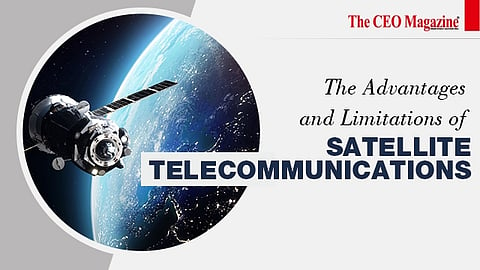
- News
- Women
- Magazine
- IndustryIndustry
- InsightsInsights
- Success Stories
- PublishPublish
- ContactContact
- Media KitMedia Kit

The Advantages and Limitations of Satellite Telecommunications
The Advantages and Limitations of Satellite Telecommunications
Satellite telecommunications is a technology that has revolutionised the way we communicate over long distances.
It uses artificial satellites orbiting the Earth to transmit and receive signals for various applications, including television broadcasting, internet connectivity, and mobile phone networks.
In this post, we will discuss the advantages and limitations of satellite telecommunications.
Global Coverage: One of the most significant advantages of satellite telecommunications is its ability to provide global coverage. Satellites can reach remote locations where traditional communication infrastructure is not available, making it an ideal solution for areas with little or no infrastructure.
High Speed: Satellite telecommunications can provide high-speed data transmission, making it a useful tool for businesses that require fast internet connectivity.
Flexibility: Satellites can be quickly repositioned to cover different areas or to provide additional capacity, making it a highly flexible solution.
Reliable: Satellite telecommunications is less susceptible to disruptions caused by natural disasters or other events that can damage traditional communication infrastructure.
Cost: Satellite telecommunications is a costly technology compared to traditional communication infrastructure. The cost of launching and maintaining satellites is high, which can make it challenging for some organisations to adopt this technology.
Latency: Satellite telecommunications can suffer from latency issues, which can cause delays in communication. This is due to the distance that signals have to travel between the Earth and the satellite, which can result in a delay of up to 0.5 seconds.
Weather Dependency: Satellite telecommunications can be affected by weather conditions such as rain, snow, or storms, which can weaken or disrupt the signal. This can cause interruptions in communication and affect the quality of the signal.
Security: Satellite telecommunications can be vulnerable to hacking or interception, which can compromise the security of the data transmitted.
Satellite telecommunications has revolutionised the way we communicate over long distances, providing global coverage and high-speed data transmission.
Despite its advantages, it also has limitations, including cost, latency, weather dependency, and security. Nevertheless, it remains a vital tool for businesses and organisations that require reliable, flexible, and global communication solutions.
Follow us on Google News
